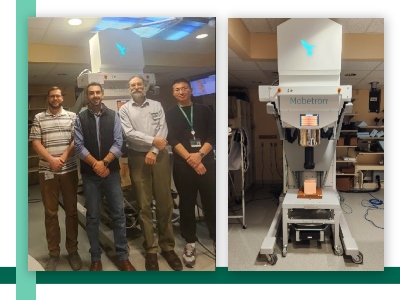
Ultra-high dose rate radiation therapy, known as FLASH, is highly effective at killing cancer cells, while sparing normal tissue from damage. Radiation oncology research scientists at Dartmouth Cancer Center are among very few in the world to show that ultra-high dose rates were possible in conventional treatment set-ups using a modified linear accelerator (machine that delivers radiation). Now, after leading several studies, the team is looking to bring this phenomenon into the clinic for the benefit of patients with the use of a new purpose-built, FLASH-capable IntraOp® Mobetron® linear accelerator.
Research scientist Wilson Schreiber measures oxygen levels in a sample with a modified clinical linear accelerator. The study will help scientists better understand the radio-chemistry differences between conventional and ultra-high dose rate radiation.
The technique he is using is called “electron paramagnetic resonance,” or EPR. Oxygen is consumed during radiation and can be detected using EPR or using optical methods.
“We achieved the first simultaneous but independent measurements of oxygen and showed excellent agreement between the two techniques. Now we can choose the best technique depending on the system being studied,” says David Gladstone.
“The FLASH effect has been challenging to reproduce,” says physicist David J. Gladstone, ScD. “Acquiring a purpose-built accelerator that requires no modifications ensures certainty as we transition to clinical studies.”
The research team is developing innovative tools for the Mobetron® as the next step toward opening a clinical study to test the safety and feasibility of bringing this revolutionary new technology to patients.
“The first trial will be for treatment in patients with lymphomas that involve the skin,” says radiation oncologist Lesley A. Jarvis, MD, PhD. “Then we’ll build on this experience by designing clinical trials for other types of cancer, possibly breast cancer or other more common types of skin cancers. The overall goal is to reduce the treatment-related side effects of radiation while maintaining or improving cure rates.”
The new machine not only allows for more functionality on the research side but can also be used clinically, once it is FDA-approved.
“Ultra-high dose rates may be beneficial to spare patients from radiation treatment damage,” says Gladstone. “We are working to test this hypothesis and hope to optimize this novel technique to offer to our patients if and when it is proven to be successful.”
Also in the research plan is a collaboration with DoseOptics, to integrate high-speed Cherenkov imaging cameras into the Mobetron. The Dartmouth-engineered technology in these cameras allows radiation therapists to physically see where the invisible radiation beam contacts the patient’s skin, and make adjustments in real-time for the most precise delivery possible.

“We are proud that IntraOp Mobetron with FLASH-IQ has demonstrated its readiness to revolutionize cancer treatment, and Dartmouth has chosen this groundbreaking new technology to help patients who need it the most,” says Sanjay Arora, CEO at IntraOp.
Radiation therapy is a highly technical field. Advancements require skill in physics, engineering, biology and clinical radiation oncology. With expertise in each of these areas, the Dartmouth Cancer Center radiation oncology research team is well poised to translate ultra-high dose rate technology to the clinic with the hope of reducing treatment side effects and improving the quality of life for patients with cancer.
* * *
David J. Gladstone, ScD, is a member of Dartmouth Cancer Center’s Translational Engineering in Cancer (TEC) research program, Professor of Engineering at Dartmouth’s Thayer School of Engineering, and Professor of Medicine at Dartmouth’s Geisel School of Medicine. His research interests include imaging of Cherenkov emission for radiotherapy quality assurance and recently, the characterization of ultra-high dose rate radiotherapy to elicit the FLASH effect to spare normal tissues.
Lesley A. Jarvis, MD, PhD, is a clinical radiation oncologist, member of TEC and Associate Professor of Medicine at Geisel. As a clinician-scientist, she will serve as Principal Investigator of upcoming clinical trials. Her research interests include designing and implementing clinical trials for the translation of novel radiation devices into clinical use.